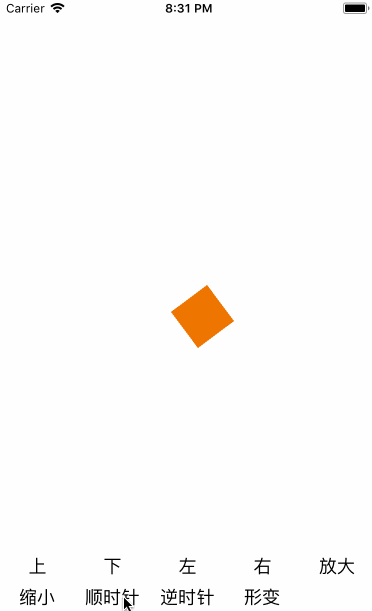形变动画即形状的旋转,位移,缩放和形状的变化。
官网地址:
https://developer.apple.com/documentation/coregraphics/cgaffinetransform-rb5?language=objc
要想达到我们所需要的结果,需要使用到CGAffineTransform
CGAffineTransform很多人认为这是个类。抱歉这不是类。官网说的很清楚。
An affine transformation matrix for use in drawing 2D graphics.
一个用于绘制2D图形的仿射变换矩阵。
是的。一种矩阵.
打开CGAffineTransform.h 文件我们就可以看到的。
struct CGAffineTransform {
CGFloat a, b, c, d;
CGFloat tx, ty;
};
在程序内部我们对其进行变化的时候,其实内部代码改的就是这个矩阵的数据。
具体的矩阵原理 传送门:
https://www.zhihu.com/question/21351965
原理看不懂,我们就来看看源码:
CGPointApplyAffineTransform
返回一个已存在点的仿射变换所产生的点。
方法定义:
CG_EXTERN CGPoint CGPointApplyAffineTransform(CGPoint point,
CGAffineTransform t) CG_AVAILABLE_STARTING(__MAC_10_0, __IPHONE_2_0);
CG_INLINE CGPoint
__CGPointApplyAffineTransform(CGPoint point, CGAffineTransform t)
{
CGPoint p;
p.x = (CGFloat)((double)t.a * point.x + (double)t.c * point.y + t.tx);
p.y = (CGFloat)((double)t.b * point.x + (double)t.d * point.y + t.ty);
return p;
}
可以看到,参数中的坐标点的计算方式
即ax+cy+tx负责坐标x
即bx+dy+ty负责坐标y
CGSizeApplyAffineTransform
通过对现有高度和宽度的转换来返回高度和宽度。
方法定义
CG_EXTERN CGSize CGSizeApplyAffineTransform(CGSize size, CGAffineTransform t)
CG_AVAILABLE_STARTING(__MAC_10_0, __IPHONE_2_0);
CG_INLINE CGSize
__CGSizeApplyAffineTransform(CGSize size, CGAffineTransform t)
{
CGSize s;
s.width = (CGFloat)((double)t.a * size.width + (double)t.c * size.height);
s.height = (CGFloat)((double)t.b * size.width + (double)t.d * size.height);
return s;
}
aw+ch可以得到宽度width
bw+dh可以得到高度height
这样想的其实也简单多了
要是还不行,那只能好好学学高中的矩阵入门基础了,大学的线性代数。
CG_INLINE 表示内联,即在编译的时候将函数体替换函数调用,从而不需要将parameter,return address进行push/pop stack的操作,从而加速app的运行,然而,会增加二进制文件的大小。
CGAffineTransform它所定义的类型很多,我们来介绍一下:
Creating an Affine Transformation Matrix
直接创建一个新的变换矩阵
//设置完整的变形矩阵
CGAffineTransformMake
//旋转
CGAffineTransformMakeRotation
//缩放
CGAffineTransformMakeScale
//位移
CGAffineTransformMakeTranslation
CGAffineTransformMake
它表示一个新的仿射变换矩阵
方法定义:
CGAffineTransform CGAffineTransformMake(CGFloat a, CGFloat b, CGFloat c, CGFloat d, CGFloat tx, CGFloat ty);
CGAffineTransformMake 可以设置比较完整的矩阵.通过它就可以直接设置旋转,缩放,位移的操作的矩阵
它的属性设置可以看下图:
可以看到我们主要是设置它的6个值,最后算出它的坐标x,y。其中第三列的0,0,1是固定不动的哦。
以上的方法,在调用的时候每次都是初始值。
以下的方法,在调用的时候都会之前已经修改过的基础上进行变换。
Modifying Affine Transformations
创建一个新的或者在原来基础上修改的变换矩阵。
方法:
CGAffineTransformTranslate
它的属性设置图:
根据上面的计算公式,设置tx,ty的值就直接相当于设置它的坐标x,y了。通过设置它的坐标我们就可以很轻松的实现它的位移操作了。
CGAffineTransformScale
方法定义:
CGAffineTransform CGAffineTransformScale(CGAffineTransform t, CGFloat sx, CGFloat sy);
sx,sy的值等于1为不变,小于1为缩小,大于1为放大
CGAffineTransformRotate
用于图形旋转
方法定义
CGAffineTransform CGAffineTransformRotate(CGAffineTransform t, CGFloat angle);
In iOS, a positive value specifies counterclockwise rotation and a negative value specifies clockwise rotation. In macOS, a positive value specifies clockwise rotation and a negative value specifies counterclockwise rotation.
在iOS中,一个正值指定了逆时针旋转,而负值则指定顺时针旋转。在macOS中,一个正的值指定顺时针旋转,一个负的值指定逆时针旋转。
官网的翻译意思是这样的。然后经过试验,在iOS中 正数是顺时针,负数才是逆时针的。我是不是该提点建议啥的,在线等,蛮急的。
case GWAnimationRotatingClockwise://顺时针
self.showView.transform = CGAffineTransformRotate(self.showView.transform, 90);
break;
case GWAnimationRotatingAnticlockwise://逆时针
self.showView.transform = CGAffineTransformRotate(self.showView.transform, -90);
break;
其原理图如下:
填值参考:
CGAffineTransformInvert
反转当前图形的坐标
Inversion is generally used to provide reverse transformation of points within transformed objects. Given the coordinates (x,y), which have been transformed by a given matrix to new coordinates (x’,y’), transforming the coordinates (x’,y’) by the inverse matrix produces the original coordinates (x,y).
反转通常用于提供转换对象内的点的反向转换。给定的坐标(x,y)已经被一个给定的矩阵转换为新的坐标(x',y'),通过逆矩阵变换坐标(x',y')产生原始坐标(x,y)。
CGAffineTransformConcat
将两个transform组合在一起。
方法定义
CGAffineTransform CGAffineTransformConcat(CGAffineTransform t1, CGAffineTransform t2);
返回一个新的transform: t’ = t1*t2.
注意,矩阵运算不是交换——你连接矩阵的顺序是很重要的。也就是说,乘以矩阵t1乘以矩阵t2的结果并不一定等于乘以矩阵t1乘以矩阵t1。
Evaluating Affine Transforms
判断类型
CGAffineTransformIsIdentity
检查仿射转换是否为恒等变换。
CGAffineTransformEqualToTransform
检查两个仿射变换是否相等。
了解了API之后,我们就开始实践了:
设置枚举值,我们可以方便的使用
typedef NS_ENUM(NSInteger,GWDeformationType){
GWAnimationDisplacementUp,//位移
GWAnimationDisplacementDown,
GWAnimationDisplacementLeft,
GWAnimationDisplacementRight,
GWAnimationZoomEnlargement, //缩放
GWAnimationZoomOut,
GWAnimationRotatingClockwise, //旋转
GWAnimationRotatingAnticlockwise,
GWAnimationDeformation, //形变
GWAnimationInvert, //反转
GWAnimationConcat //合并
};
调用API就很简单了:
case GWAnimationDisplacementUp://上移
self.showView.transform = CGAffineTransformTranslate(self.showView.transform, 0,-10);
break;
case GWAnimationDisplacementDown://下移
self.showView.transform = CGAffineTransformTranslate(self.showView.transform, 0,10);
break;
case GWAnimationDisplacementLeft://左移
self.showView.transform = CGAffineTransformTranslate(self.showView.transform, -10,0);
break;
case GWAnimationDisplacementRight://右移
self.showView.transform = CGAffineTransformTranslate(self.showView.transform, 10,0);
break;
case GWAnimationZoomEnlargement: //放大
self.showView.transform = CGAffineTransformScale(self.showView.transform,1.5,1.5);
break;
case GWAnimationZoomOut://缩小
self.showView.transform = CGAffineTransformScale(self.showView.transform,0.5,0.5);
break;
case GWAnimationRotatingClockwise://顺时针
self.showView.transform = CGAffineTransformRotate(self.showView.transform, 90);
break;
case GWAnimationRotatingAnticlockwise://逆时针
self.showView.transform = CGAffineTransformRotate(self.showView.transform, -90);
break;
单独的使用并无什么乐趣,我们可以做个简单的动画如下图所示:
[UIView animateWithDuration:1 animations:^{
self.showView.transform = CGAffineTransformMakeScale(1.5,1.5);
} completion:^(BOOL finished) {
[UIView animateWithDuration:1 animations:^{
self.showView.transform = CGAffineTransformScale(self.showView.transform,0.5,0.5);
self.showView.transform = CGAffineTransformRotate(self.showView.transform, 180);
} completion:^(BOOL finished) {
[UIView animateWithDuration:1 animations:^{
self.showView.transform = CGAffineTransformScale(self.showView.transform,2,2);
self.showView.transform = CGAffineTransformRotate(self.showView.transform, -180);
} completion:^(BOOL finished) {
}];
}];
}];
DEMO:
https://github.com/yanggenwei/GWAnimation/tree/master











